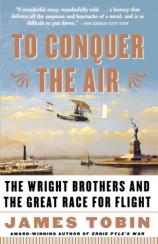To Conquer the Air: The Wright Brothers and the Great Race for Flight
Review
To Conquer the Air: The Wright Brothers and the Great Race for Flight
It is probably just a coincidence that two of the greatest
inventions of the twentieth century were fifty years apart, more or
less. Both of them celebrate an anniversary in 2003. The discovery
of the double-helix structure of DNA occurred in 1953 and the first
flight of the Wright Brothers in North Carolina happened in 1903.
James Tobin chronicles the latter event in TO CONQUER THE
AIR.
The discovery of DNA exemplifies most laboratory research: safe,
sterile and subdued, with no risk of personal danger. This
discovery was a great intellectual adventure, but without great
physical challenge. Aviation is different and it continues to be
different to this day, especially given the recent loss of seven
brave aviation pioneers in the skies over Texas in a manner in
which the Wright Brothers could have envisioned only in their most
far-flung fantasies.
TO CONQUER THE AIR is primarily a story of intellectual discovery.
It follows the parallel work of the Wright Brothers of Dayton, Ohio
and Dr. Samuel Langley of the Smithsonian Institution, all of whom
were working on powered aircraft in the early days of the twentieth
century. The Wright Brothers are famous but unknown; they appear
together in our collective unconsciousness on one windy day at
Kitty Hawk and then vanish like smoke, brothers but not
individuals. Langley's name is attached to an air force base in
Virginia but is otherwise forgotten. Tobin does the reader a signal
service in bringing the Wrights and Langley to colorful life and in
reminding us of the debt we owe to them.
Langley's tale is the least known. He was an astronomer who
developed an interest in powered flight late in life. As the
president of the Smithsonian Institution, he was perfectly placed
to lead the aviation revolution. He had the scientific knowledge,
the insight and the necessary funding from an Army contract to
build a prototype "aerodrome". He worked with some of the top
engineers in the country to build a lightweight gasoline engine to
power his craft. An unmanned version flew for about a mile in
initial tests. But the great aerodrome was destined for a series of
disasters, mostly in the full glare of national publicity.
The Wright Brothers had none of these advantages, but Tobin
painstakingly explains how they were able to achieve powered flight
when the best minds in the country could not. Their work on
gliders, their research on lift and their intimate knowledge of the
winds at Kill Devil Hill on the North Carolina coast all gave them
an edge over Langley. One of the most memorable passages in the
book describes how Charlie Taylor, the Wright's mechanic at their
bicycle shop, put together a lightweight 12-horsepower gasoline
engine out of spare parts, easily outdoing the best engine that
Langley could provide for his craft.
The story of the race for flight is not especially romantic at
times and it gets bogged down in arcane period details. Tobin might
have been better advised to leave out the endless wrangling about
the position of the Wrights' father in the United Brethren Church,
or the kite experiments of Alexander Graham Bell. But Tobin tells
his detailed, exacting story well and makes the mysteries of flight
comprehensible. He never forgets how dangerous the whole project
was (and still is, at times) and brings the Wright Brothers out of
the dust of history and into the reader's imaginations --- as
individuals, no less. TO CONQUER THE AIR is a fine book that
provides a signal service in illuminating the discovery of
flight.
Reviewed by Curtis Edmonds (curtis@txreviews.com). Curtis Edmonds is a frequent flyer and writes movie reviews at http://www.txreviews.com/. on January 23, 2011
To Conquer the Air: The Wright Brothers and the Great Race for Flight
- Publication Date: April 27, 2004
- Genres: History, Nonfiction
- Paperback: 448 pages
- Publisher: Free Press
- ISBN-10: 0743255364
- ISBN-13: 9780743255363




